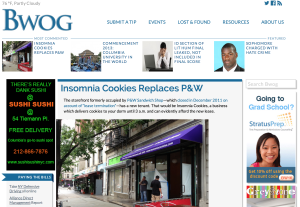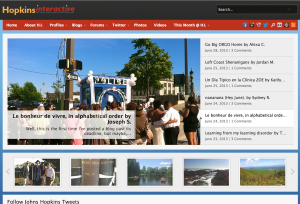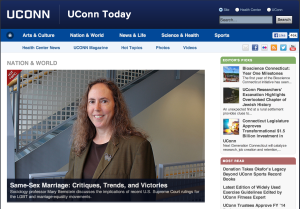7 content marketing stats that should shake higher education – and 5 ways to act on them

Higher education institutions face a content dilemma. While their target audience is the most connected generation ever, most colleges and universities struggle to produce content that connects.
Some cannot find an authentic brand voice, and instead hide behind a rigid wall of academia. Some feel uncomfortable producing conversational content and revert to repurposing text from brochures or other printed publications. And most cannot produce enough interesting content on a consistent basis to keep their websites fresh and visit-worthy.
This poses a real opportunity for higher education institutions that can break away from the pack and stand out online. Consider the following:*
- A college’s website is the first destination for many prospective students and parents when beginning to research schools.
- One out of five students removed a university from consideration after a bad experience with the school’s website.
- 66% of prospective college students believe schools should have a social media presence.
- 68% of high school students use social media to research schools; 38% have used social media as a resource when deciding where to enroll; and 45% said they have been influenced by a school’s engagement on social media.
- More than 90% of colleges have a Facebook fan page and 80% of prospective students use Facebook. Yet, just slightly more than one-quarter of prospective students actually view a college’s social media profile. Why? Lack of compelling content.
- One in three schools says social media is more efficient than traditional media in reaching their target audience.
- Over the past two years, the number of colleges with blogs has grown from 36% to 55%, pointing to the growing recognition that content is key.
Some institutions are already doing it right, finding ways to create meaningful connections with their audiences through simple, honest storytelling. These institutions are experimenting with ways to harness the vast amount of content created by faculty, staff, students, alumni and fans – and they can teach other colleges and universities a thing or two. Here are some of the top takeaways from these A+ content creators:
1. Make content creation a joint effort – and a teaching opportunity.
The Unofficial Stanford Blog is a student group devoted to the authentic expression of Stanford voices and perspectives. It’s a community of students, faculty and staff passionate about blogging and dedicated to innovation in online content and distribution. By having various audiences within the university work together on producing content, Stanford is creating a hub rich with differing viewpoints and perspectives, which appeals to a broader audience.

2. Don’t be afraid to have some fun.
The Bwog is the 24/7 blog incarnation of The Blue and White, Columbia University’s monthly undergraduate magazine. It updates multiple times daily, bringing readers Columbia news, gossip, arts, sports and free food. The Bwog is the place to find out what’s big on and around campus. This content hub doesn’t take itself too seriously. It provides a flavor of the student spirit you’ll find on campus without taking away from Columbia’s strong brand.

3. Let the conversations happen – whether they’re negative or positive.
Hopkins Interactive is a social media website designed to enable prospective and admitted students to Johns Hopkins to connect with the university by offering them candid, uncensored information about student life on campus and throughout Baltimore. It welcomes conversations and doesn’t shy away from the topics students care about.

4. Take your news seriously.
UConn Today covers the University of Connecticut in the same way a local paper would cover a town. This in-depth blog features Arts & Culture, Nation & World, News & Life, Science & Health, Sports and more. Updated frequently each day, UConn Today inserts the university into current conversations happening in the academic world, as well as with topical news. It’s helping to position UConn as a resource while legitimizing its point of view.

5. Step outside content produced by institutions to find out what college students really want.
There are many fantastic blogs out there focused on the college experience, run independently from specific colleges and universities. Each of these provide a fantastic model for content marketing and curation:
- http://www.hackcollege.com/
- http://www.collegecures.com/
- http://www.collegenews.com/
- http://collegeinfogeek.com/
- http://campusgrotto.com/
- http://thechoice.blogs.nytimes.com/
Higher education institutions must start to capitalize on the diverse and rich content produced by professors, students, alumni and others in order to enhance their online presence. By connecting with prospective students and families online, they’ll improve their chances of making that virtual visit a reality.
(*Resources: 2011 E-Expectations Report sponsored by Noel-Levitz and the National Research Center for College and University Admissions; Zinch, 2012; UMass Dartmouth, BestCollegesOnline.com.)
MORE ARTICLES
-
 What Is Your Private School’s Bold & Unifying Big Promise?
What Is Your Private School’s Bold & Unifying Big Promise? -
 AI Writing Prompts to Power Private School Storytelling
AI Writing Prompts to Power Private School Storytelling -
 When to Outsource Your Private School Content Marketing to an Expert
When to Outsource Your Private School Content Marketing to an Expert -
 3 Unique Ways to Attract Dream Families with Content
3 Unique Ways to Attract Dream Families with Content -
 4 Quick & Easy Ways to Improve Your School’s Emails
4 Quick & Easy Ways to Improve Your School’s Emails -
 The Best Content Marketing Resources for Independent Schools
The Best Content Marketing Resources for Independent Schools -
 How to Create Qualified Leads for Your Private School
How to Create Qualified Leads for Your Private School -
 10 School Storytelling Mistakes That Cause Your Audience to Disconnect
10 School Storytelling Mistakes That Cause Your Audience to Disconnect
[…] that are not leveraging tech in their marketing efforts are quickly coming up short. According to Noel Levitz, one out of five prospective students removed a university from their consideration after a bad […]
[…] farvi capire quanto sia penalizzante un sito non all’altezza basti pensare che uno studente su cinque non prende più in considerazione una scuola dopo una esperienza negativa avuta sul suo sito web, […]